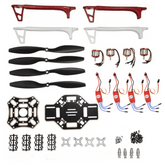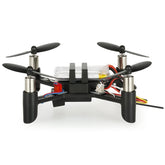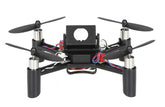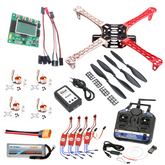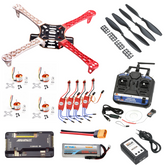Top Applications of Drones
Summary
Explore the cutting-edge realm of drone technology in our blog, "Top Applications of Drones." Uncover the diverse uses of drones, from defense to agriculture. Delve into the military sector, discovering how drones play a pivotal role. Witness the agricultural revolution as we unveil the benefits and workings of agricultural drones. Unravel the mechanics behind delivery drones, shaping the future of logistics. Join us on a journey through the skies, where innovation meets application. From defense strategies to crop monitoring, our blog unveils the limitless potential of drones. Elevate your knowledge and click into the future with our comprehensive exploration!
What are the uses of drones?
Drones are increasingly being used in various industries, providing multiple advantages for professionals of all kinds. Drones have a wide range of uses and applications.
In agriculture, commercial drone technology is revolutionizing the way farmers carry out crop management activities such as spraying chemical solutions on crops to combat pests or gathering data from sensors placed within fields for advanced analytics purposes. In construction operations like surveying land plots before building begins or inspecting tall buildings, they allow workers to survey inaccessible areas quickly and without putting personnel at risk from heights which might be dangerous if accessed by conventional methods. Furthermore, some private companies use them when delivering goods; usually, packages weighing up to 30 pounds can be delivered safely using these devices due to their stability and efficiency while airborne compared to traditional transportation methods (van/trucks). Additionally, military forces around the world employ UAVs mostly for surveillance missions but also sometimes carrying payloads featuring weapons making them particularly suitable since no human lives would potentially be put in danger during deployment mission scenarios even though this depends on war context variables related to specific locations where operations take place.
How drones are useful in the defence sector?
Drones have become increasingly useful in the defence sector due to their ability to be used for surveillance, reconnaissance and intelligence gathering. They provide advanced capabilities that can improve battle effectiveness by delivering real-time data on enemy activity without putting personnel at risk of harm or loss of life. Drones enable military commanders to gain an up-to-date overview of a battlefield scenario with greater speed than previously possible, providing strategic insight into operations as they unfold.

In addition, drones are capable of sharing detailed imagery across government networks further enhancing situational awareness while ensuring secure delivery means minimum response time is achieved when responding to threats identified during mission execution phases. Furthermore, modern technologies allow unmanned airframes utilizing multi-sensor payloads able to gather metrics which assist in making more informed decisions resulting from analysis processed within minutes accessible via handheld devices enabling timely reactions aimed towards preventing potential conflicts before they occur leading consequently decreasing operational costs associated with long term deployments abroad ensuring domestic safety aligned with legislative directives enforced upon modern armed forces today.
How drones are used in military?
Drones are becoming increasingly important in the military sector due to their ability to precisely and quickly deliver goods or munitions, covertly spy on enemy areas without risk of harm to personnel, monitor battlefields from a safe distance for tactical information gathering as well provide humanitarian aid. One example is the use of drones by UAVs (Unmanned Aerial Vehicles) that allow troops on ground operations to close intelligence surveillance environments.
The drone can silently move into an area providing live video streaming with thermal imaging which gives real-time mission critical images through thick foliage shielding hostile positions providing an invaluable advantage during combat missions allowing greater accuracy while minimizing friendly casualties often associated with ground-based countermeasures attempts. Drones also have been known to be used for medical evacuation purposes where injured soldiers were outfitted safely within a custom-built gurney transported aboard transport vehicles then aerial deployed directly over locations when roads would otherwise not permit such missions dependent upon time-sensitive circumstances requiring immediate action under dire environments normally too difficult if even feasible at times by any other practical means available.
How are drones used in agriculture?
Drones are being used increasingly in the agricultural industry, as they provide a number of benefits that make them an attractive tool for farmers and agronomists. With precise aerial capabilities, drones enable precision information gathering on crop health and yield mapping with fast imagery acquisition from multiple angles. This can help maximize yields while reducing costs associated with manual labour or traditional air-based reconnaissance methods such as manned aircraft.

Additionally, additional sensors mounted onto drones give insight into soil data analysis by sensing chlorophyll content - which gives us more understanding of overall plant/crop health. Drones also have applications when it comes to spraying fertilizers through their pesticide application systems – drastically reducing drift rates compared to ground-based sprayers and creating higher levels of accuracy in areas otherwise difficult to reach manually (ease & accuracy). Overall, drones offer professionals within the agriculture sector unprecedented access to information about field conditions without needing physical presence at each location; significantly increasing efficiency across operations while minimizing time spent acquiring images or carrying out surveys over large fields spanning hundreds of hectares at a time!
What are the benefits of using drones in agriculture?
Using drones in agriculture offers numerous benefits to farmers around the world. Here are some of those advantages:
- Unparalleled Monitoring—Drones can be used for surveying a field and monitoring crops, allowing more efficient management of resources. This reduces labour costs as well as inconveniences associated with manual assessment methods while yielding better accuracy compared to traditional techniques such as satellite imagery or simply walking through fields;
- Enhanced Precision in Crop Analysis—Drone technology enables quick crop inspections that allow farmers to identify items like weeds or pests early on before they grow into bigger problems or become harder (and costlier) to treat;
- Optimized Scheduling of Inputs– With detailed insights about conditions on farmlands, drone images can help schedule appropriate amounts of inputs at precisely strategic points throughout the growth cycle optimizing input expense by using just enough fertilizer and water where needed instead of eking out productivity gains from every drop applied-saving time & money;
- Reduced Risk Through Automation – By streamlining many mundane farming operations, autonomous aerial vehicles drastically reduce risks involved which would otherwise have been incurred if done manually over rough terrain;
- Improved Logistics– Drone imaging helps provide real-time traffic data for smart routing, making it easier & faster than ever before to transport goods between farms/warehouses thereby cutting down delivery times across distances large and small.
How do agricultural drones work?
Agricultural drones are becoming increasingly popular in today's agriculture industry. By using the latest drone technology, farmers and growers can gain a better understanding of their crops while reducing labour costs. With each flight, they collect data that helps them optimize crop productivity by monitoring plant health from different angles and distances with unprecedented accuracy. This provides an advantage over traditional methods of surveying fields which often require manual work or specialized equipment such as manned aircraft to achieve similar results.
Drones use high-resolution cameras to capture images from various heights above ground level (AGL) offering detailed insights about the condition of your land - including any potential issues related to pests, diseases or weeds – all without ever stepping foot on it! They also offer improved efficiency when mapping large farmlands allowing for more precise application control systems whether used for spraying herbicides/fertilizers or irrigating certain areas only if needed due to soil differences detected by multispectral sensors present in most modern solutions. Additionally, this technology is useful during harvest times when automated harvesting operations become possible thanks to tractor guidance tools provided via real-time 3D maps generated throughout the growing season keeping operators informed at all times about yield quality directly from field location thus avoiding unnecessary transportation trips saving fuel resources meanwhile providing safe working environment since dangerous terrain passages can be easily eliminated before sending staff out there, therefore creating much faster response rate regarding seasonal management activities up ahead!
How do delivery drones work?
Delivery drones are rapidly becoming the preferred method of delivering goods and services in an efficient, cost-effective manner. Drones work by being flown autonomously using GPS navigation systems to locate their destination, allowing them to deliver packages without human intervention. They can be used for both short-term deliveries like parcels or food orders as well as long-distance journeys such as courier transport from one city to another.

Delivering with drones is much faster than traditional methods; they are able to cover more ground quickly and make multiple delivery stops within a single trip instead of having the driver take time out for each stop separately during a longer journey on foot or by car. Additionally, they’re equipped with sensors that allow them to detect potential obstacles along their route so there's no risk involved when it comes crashing into buildings or trees – something which could have disastrous consequences if done manually!
Beyond speed advantages, drone delivery also offers plenty of other benefits: automated package tracking means you can always know where your cargo is at any given moment; detailed analytics helps ensure maximum efficiency across different areas; remote control abilities let users manage several operations simultaneously even while away from home/business premises - all these features help reduce costs associated with labour & transportation times while increasing customer satisfaction rates due too quick turnarounds & better visibility over product location updates throughout its transit lifecycle period!
Conclusion
In conclusion, the versatility of drones extends far beyond our imaginations, reaching new heights in various sectors. From enhancing defense capabilities to revolutionizing agriculture and streamlining delivery services, drones have proven indispensable. Their efficiency, precision, and adaptability continue to redefine industries. As technology evolves, so will the applications of drones, promising an exciting future. Stay tuned to witness the unfolding chapters of innovation and transformation, as drones soar to new horizons, bridging gaps, and propelling us into a future where the sky is not the limit but the beginning of endless possibilities. Embrace the drone revolution today!



